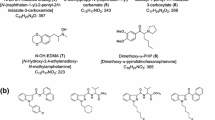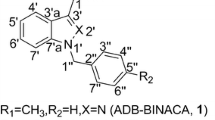Abstract
From November 2013 to May 2014, 19 newly distributed designer drugs were identified in 104 products in our ongoing survey of illegal products in Japan. The identified compounds included 8 synthetic cannabinoids, FUB-PB-22 (1), 5-fluoro-NNEI indazole analog (5-fluoro-MN-18, 2), AM-2201 indazole analog (THJ-2201, 3), XLR-12 (4), 5-fluoro-AB-PINACA (5), 5-chloro-AB-PINACA (6), AB-CHMINACA (7), and 5-fluoro-AMB (8); 5 cathinone derivatives, DL-4662 (9), α-PHP (10), 4-methoxy-α-POP (11), 4-methoxy-α-PHPP (12), and 4-fluoro-α-PHPP (13); and 6 other substances, namely, the benzofuran derivative 2-(2-ethylaminopropyl)benzofuran (2-EAPB, 14), nitracaine (15), diclofensine (16), diphenidine (17), 1-benzylpiperidine (18), and acetylfentanyl (19). To our knowledge, this is the first report on the chemical properties of compounds 9–11 and 14. A total of 33 designer drugs, including compounds 1–19, were detected in the 104 illegal products, in 60 different combination patterns. The numbers of detected compounds per product ranged from 1 to 7. In addition, several products contained three different types of compounds, such as synthetic cannabinoids, cathinone derivatives, and phenethylamine derivatives per product. It is apparent that the types of compounds emerging as illegal products are becoming more diverse, as are their combinations.










Similar content being viewed by others
References
Uchiyama N, Kikura-Hanajiri R, Kawahara N, Goda Y (2009) Identification of a cannabimimetic indole as a designer drug in a herbal product. Forensic Toxicol 27:61–66
Uchiyama N, Kawamura M, Kikura-Hanajiri R, Goda Y (2012) Identification of two new-type synthetic cannabinoids, N-(1-adamantyl)-1-pentyl-1H-indole-3-carboxamide (APICA) and N-(1-adamantyl)-1-pentyl-1H-indazole-3-carboxamide (APINACA), and detection of five synthetic cannabinoids, AM-1220, AM-2233, AM-1241, CB-13 (CRA-13), and AM-1248, as designer drugs in illegal products. Forensic Toxicol 30:114–125
Kikura-Hanajiri R, Uchiyama N, Kawamura M, Goda Y (2013) Changes in the prevalence of synthetic cannabinoids and cathinone derivatives in Japan until early 2012. Forensic Toxicol 31:44–53
Uchiyama N, Matsuda S, Wakana D, Kikura-Hanajiri R, Goda Y (2013) New cannabimimetic indazole derivatives, N-(1-amino-3-methyl-1-oxobutan-2-yl)-1-pentyl-1H-indazole-3-carboxamide (AB-PINACA) and N-(1-amino-3-methyl-1-oxobutan-2-yl)-1-(4-fluorobenzyl)-1H-indazole-3-carboxamide (AB-FUBINACA), identified as designer drugs. Forensic Toxicol 31:93–100
Takahashi K, Uchiyama N, Fukiwake T, Hasegawa T, Saijou M, Motoki Y, Kikura-Hanajiri R, Goda Y (2013) Identification and quantitation of JWH-213, a cannabimimetic indole, as a designer drug in a herbal product. Forensic Toxicol 31:145–150
Uchiyama N, Matsuda S, Kawamura M, Kikura-Hanajiri R, Goda Y (2013) Two new-type cannabimimetic quinolinyl carboxylates, QUPIC and QUCHIC, two new cannabimimetic carboxamide derivatives, ADB-FUBINACA and ADBICA, and five synthetic cannabinoids detected with a thiophene derivative α-PVT and an opioid receptor agonist AH-7921 identified in illegal products. Forensic Toxicol 31:223–240
UNODC (2014) 2014 Global synthetic drugs assessment. Amphetamine-type stimulants and new psychoactive substances, May 2014. http://www.unodc.org/documents/scientific/2014_Global_Synthetic_Drugs_Assessment_web.pdf. Accessed May 2014
EMCDDA (2014) European drug report 2014: trends and developments, May 2014. http://www.emcdda.europa.eu/attachements.cfm/att_228272_EN_TDAT14001ENN.pdf. Accessed May 2014
Uchiyama N, Matsuda S, Kawamura M, Kikura-Hanajiri R, Goda Y (2014) Identification of two new-type designer drugs, a piperazine derivative MT-45 (I-C6) and a synthetic peptide Noopept (GVS-111), with a synthetic cannabinoid A-834735, a cathinone derivative 4-methoxy-α-PVP and a phenethylamine derivative 4-methylbuphedrine from illegal products. Forensic Toxicol 32:9–18
Uchiyama N, Shimokawa Y, Matsuda S, Kawamura M, Kikura-Hanajiri R, Goda Y (2014) Two new synthetic cannabinoids, AM-2201 benzimidazole analog (FUBIMINA) and (4-methylpiperazin-1-yl)(1-pentyl-1H-indol-3-yl)methanone (MEPIRAPIM), and three phenethylamine derivatives, 25H-NBOMe 3,4,5-trimethoxybenzyl analog, 25B-NBOMe, and 2C-N-NBOMe, identified in illegal products. Forensic Toxicol 32:105–117
Uchiyama N, Matsuda S, Kawamura M, Shimokawa Y, Kikura-Hanajiri R, Aritake K, Urade Y, Goda Y (2014) Characterization of four new designer drugs, 5-chloro-NNEI, NNEI indazole analog, α-PHPP and α-POP, with 11 newly distributed designer drugs in illegal products. Forensic Sci Int 243:1–13
Uchiyama N, Kawamura M, Kikura-Hanajiri R, Goda Y (2013) URB-754: a new class of designer drug and 12 synthetic cannabinoids detected in illegal products. Forensic Sci Int 227:21–32
Frost JM, Dart MJ, Tietje KR, Garrison TR, Grayson GK, Daza AV, El-Kouhen OF, Yao BB, Hsieh GC, Pai M, Zhu CZ, Chandran P, Meyer MD (2010) Indol-3-ylcycloalkyl ketones: effects of N1 substituted indole side chain variations on CB2 cannabinoid receptor activity. J Med Chem 53:295–315
Buchler IP, Hayes MJ, Hegde SG, Hockerman SL, Jones DE, Kortum SW, Rico JG, Tenbrink RE, Wu KK (2009) Indazole derivatives as CB1 receptor modulators and their preparation and use in treatment of diseases. Patent: WO/2009/106980 September, 2009
Iversen L, Gibbons S, Treble R, Sedtola V, Huang X-P, Rolth BL (2013) Neurochemical profiles of some novel psychoactive substances. Eur J Pharmacol 700:147–151
Advisory Council on the Misuse of Drugs (ACMD) (2013) Benzofurans: a review of the evidence of use and harm. ACMD, London. https://www.gov.uk/government/uploads/system/uploads/attachment_data/file/261783/Benzofuran_compounds_report.pdf. Accessed May 2014
Power JD, Scott KR, Gardner EA, Curran McAteer BM, O’Brien JE, Brehon M, Talbot B, Kavanagh PV (2014) The syntheses, characterization and in vitro metabolism of nitracaine, methoxypiperamide and mephtetramine. Drug Test Anal. doi:10.1002/dta.1616
Nakachi N, Kiuchi Y, Inagaki M, Inazu M, Yamazaki Y, Oguchi K (1995) Effects of various dopamine uptake inhibitors on striatal extracellular dopamine levels and behaviors in rats. Eur J Pharmacol 281:195–203
Berger ML, Schweifer A, Rebernik P, Hammerschmidt F (2009) NMDA receptor affinities of 1,2-diphenylethylamine and 1-(1,2-diphenylethyl)piperidine enantiomers and of related compounds. Bioorg Med Chem 17:3456–3462
Kikura-Hanajiri R, Uchiyama N, Kawamura M, Goda Y (2014) Changes in the prevalence of new psychoactive substances before and after the introduction of the generic scheduling of synthetic cannabinoids in Japan. Drug Test Anal. doi:10.1002/dta.1584
Acknowledgments
Part of this work was supported by a Health and Labor Sciences Research Grant from the Ministry of Health, Labour, and Welfare, Japan.
Conflict of interest
There are no financial or other relations that could lead to a conflict of interest.
Author information
Authors and Affiliations
Corresponding author
Electronic supplementary material
Below is the link to the electronic supplementary material.
Rights and permissions
About this article
Cite this article
Uchiyama, N., Shimokawa, Y., Kawamura, M. et al. Chemical analysis of a benzofuran derivative, 2-(2-ethylaminopropyl)benzofuran (2-EAPB), eight synthetic cannabinoids, five cathinone derivatives, and five other designer drugs newly detected in illegal products. Forensic Toxicol 32, 266–281 (2014). https://doi.org/10.1007/s11419-014-0238-5
Received:
Accepted:
Published:
Issue Date:
DOI: https://doi.org/10.1007/s11419-014-0238-5




